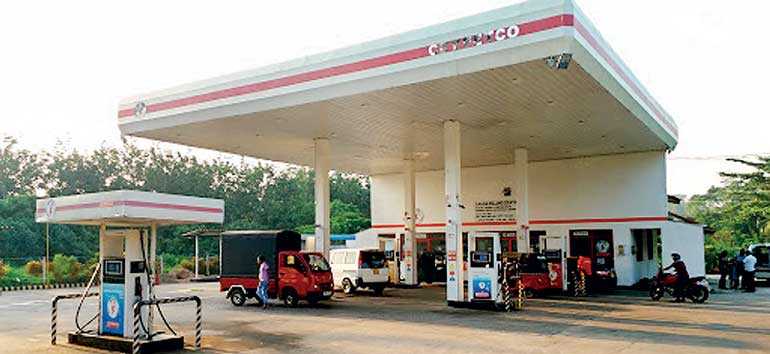Saturday Apr 19, 2025
Saturday Apr 19, 2025
Tuesday, 6 April 2021 00:00 - - {{hitsCtrl.values.hits}}

As a net importer of oil, Sri Lanka’s largest import bill is on crude oil and refined petroleum, and in last year, Sri Lanka imported fuel—crude oil, refined petroleum and coal—worth over $ 2.5 billion and in 2019 the figure stood at over $ 3.8 billion. With merchandise exports little over $ 10 billion, containment of the country’s oil bill remains a must
 The term hedging has become an almost a taboo word in Sri Lanka’s financial literature.
The term hedging has become an almost a taboo word in Sri Lanka’s financial literature.
Hedging your risk is a method of prudent risk management and is practiced by virtually every country and large corporation on the planet to maintain price stability against unanticipated price fluctuations.
However, in Sri Lanka, after the infamous ‘hedging deal’ where the Ceylon Petroleum Corporation (CPC), albeit being the largest business entity in the country in terms of revenue, got into an ugly mess by hedging international oil prices via an ill-fated hedging arrangement, the practice of such financial instruments is frowned upon.
To this day, the word ‘hedging’ is more or less shunned by the authorities and public alike, and has become a fine example of a perennial problem-solving method when things go south, throw the baby out with the bathwater!
The definition of a hedge is a financial technique that helps to reduce or mitigate the effects of measurable type of risk from the future changes in the fair value of commodities, cash flows, securities, currencies, assets and liabilities. It is a kind of an insurance that does not eliminate the risk completely but mitigates its effect. In other words, it is a risk-reducing tool wherein derivatives and other instruments are used to offset future changes in the value of securities, currencies, assets, etc.
Hence, a hedge is quintessentially a bet on what the future prices of a commodity like oil and coal. Hedging your risks comes in different forms and the common instruments used include forward contracts, futures contracts, swaps, option contracts, insurance and collars.
From the above, the forwards and options are the most widely used hedging instruments, but they come with a premium or cost. A forward contract is entering into an agreement with a supplier to purchase a commodity at a pre-determined price and quantity. A forward contract is risky to a certain extent, as the buyer has no option to opt out if there’s a downturn in world commodity prices.
The ill-fated CPC hedge was done via a zero-cost hedge, which is known as a ‘collar’. Any financial instrument factors the Time Value of Money (TMV) as the base of the valuation of the instrument. A ‘collar’ carries no premium hence in return offers a very limited upside risk (ceiling) and a high downside risk (floor).
For example on a zero collar, if oil prices move up the benefit of the price increase is capped at a low level hence the upside benefit for the instrument holder such as the CPC is limited. However, if the price moves down then the downside risk for the instrument holder is unlimited.
Oil prices moved down after the US Federal Reserve increased rates, which resulted in a crash in commodity prices. Despite the crash in oil prices, due to the ‘collar’ contract CPC had to buy oil at the previously agreed price.
Oil price gradually on the up again
With economic activities rebounding as the COVID-19 pandemic fears recede, global oil prices are forecasted to go up.
Also, according to analysts, historically crude oil prices tend to go up under Democrat governments in the United States. During the previous Trump administration (Republican), oil prices remained stable. Under the current Biden administration (Democrat), global crude oil prices are now above $ 60 per barrel. This was below US $ 60 a barrel during Trump administration. The Suez blockade is also likely to push up commodities prices, at least temporarily.
In this backdrop, it is vital for Sri Lanka to explore all the avenues to mitigate risks coming from potentially higher oil prices, and revisiting hedging options with an open mind may not hurt. After all, the Central Bank is basing all its economic forecasts on the assumption that global crude oil prices will remain around $ 60 a barrel this year.
As a net importer of oil, Sri Lanka’s largest import bill is on crude oil and refined petroleum, and in last year, Sri Lanka imported fuel—crude oil, refined petroleum and coal—worth over $ 2.5 billion and in 2019 the figure stood at over $ 3.8 billion. With merchandise exports little over $ 10 billion, containment of the country’s oil bill remains a must.
However, a decade later, have we become wiser? Have we learnt the lessons from previous mistakes? The CPC after the severe backlash from the previous attempt to mitigate risks has completely shied away from using derivatives to manage price volatility. But, the country solely depends on imported fossil fuels for its transport and partly for its energy needs, hence oil prices play a key role in Sri Lanka’s economic and social well-being.
How to move forward
To move forward, the policymakers should look at setting up a professional outfit, which would act as an advisory board, in studying and proposing financial tools and mechanisms to fight price volatility. This outfit should include experienced central bankers, representatives of professional bodies like CA Sri Lanka and CFA Sri Lanka, relevant ministry secretaries, bankers, selected private sector professionals with knowledge in financial derivatives, university academics, etc.
At the same time, the relevant public corporation, which intends to use these instruments to mitigate risks, should also employ professional fund managers with international experience in derivative instruments, who have the capacity to evaluate and forecast on potential global prices. With all these checks and balances in place, transparency of the processes and the integrity of those involved, remain paramount.
Managing public opinion
Managing public opinion on hedging also remains crucial if Sri Lanka plans to revisit these financial instruments in future to mitigate price volatility. The negative connotation associated with the word hedging due to past bad experiences should be repaired and public and media should be made aware that if used in a prudent manner, after a thorough study of the terms and conditions, these tools can be advantageous to the country in the long run.
The Central Bank and various professional bodies can play a key role in educating the public and the media on what hedging is and its pros and cons. The world hedging continues to be demonised in the local media even today.
In conclusion, sidestepping from various financial instruments available in today’s modern financial world is simply not an option. With pressure on the national economy continues to mount, Sri Lanka should explore all options to mitigate risks stemming from price volatility, including hedging instruments to maintain price stability.
(The writer is the General Manager/CEO of People’s Bank)
Discover Kapruka, the leading online shopping platform in Sri Lanka, where you can conveniently send Gifts and Flowers to your loved ones for any event including Valentine ’s Day. Explore a wide range of popular Shopping Categories on Kapruka, including Toys, Groceries, Electronics, Birthday Cakes, Fruits, Chocolates, Flower Bouquets, Clothing, Watches, Lingerie, Gift Sets and Jewellery. Also if you’re interested in selling with Kapruka, Partner Central by Kapruka is the best solution to start with. Moreover, through Kapruka Global Shop, you can also enjoy the convenience of purchasing products from renowned platforms like Amazon and eBay and have them delivered to Sri Lanka.
Discover Kapruka, the leading online shopping platform in Sri Lanka, where you can conveniently send Gifts and Flowers to your loved ones for any event including Valentine ’s Day. Explore a wide range of popular Shopping Categories on Kapruka, including Toys, Groceries, Electronics, Birthday Cakes, Fruits, Chocolates, Flower Bouquets, Clothing, Watches, Lingerie, Gift Sets and Jewellery. Also if you’re interested in selling with Kapruka, Partner Central by Kapruka is the best solution to start with. Moreover, through Kapruka Global Shop, you can also enjoy the convenience of purchasing products from renowned platforms like Amazon and eBay and have them delivered to Sri Lanka.